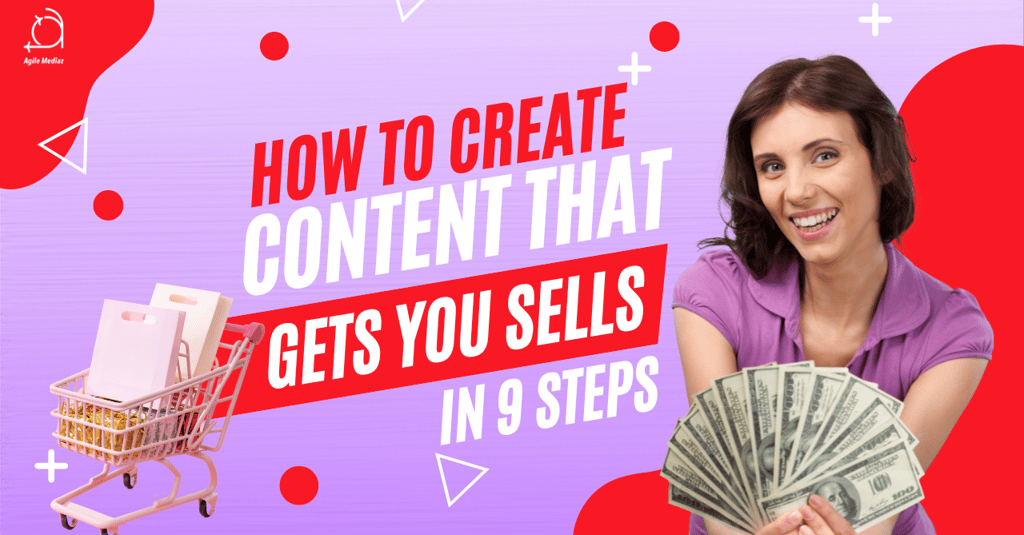How to Create Content That Gets You Sells In 9 Steps
A detailed guide on creating blogs, videos, and social media posts that engage your audience, provide value, and drive conversions for your business.
SMALL BUSINESSMARKETINGSTRATEGYCONTENT CREATION
Agile Mediaz
1/5/20253 min read


Content marketing is more than just creating pretty posts or entertaining videos—it’s about driving action. Whether your goal is to generate leads, increase sales, or build brand loyalty, effective content marketing helps your audience connect with your message and take the next step.
In this guide, we’ll break down how to create blogs, videos, and social media posts that not only engage but also convert.
Step 1: Understand Your Audience
Effective content starts with understanding who you’re speaking to. Without this foundation, your efforts might miss the mark.
How to Get to Know Your Audience:
Define Your Buyer Persona: Identify key traits like demographics, challenges, and goals. For example, “Emma, a 30-year-old entrepreneur, needs tools to save time and grow her small business.”
Research Pain Points: What problems does your audience face that your product or service solves?
Engage Directly: Use surveys, polls, or direct messages to learn what your audience wants.
Final Thoughts: Content That Sells Builds Relationships
Content marketing isn’t just about selling—it’s about building trust, providing value, and creating a connection with your audience. By understanding your audience, delivering valuable content, and guiding them toward action, you can create blogs, videos, and posts that don’t just engage but also convert.
Step 2: Set Clear Goals for Your Content
Every piece of content you create should have a purpose. Whether it’s driving traffic, capturing leads, or boosting sales, clear goals guide your content creation process.
Examples of Content Goals:
Blog Posts: Educate and build trust, such as “5 Ways to Save Time with [Your Product].”
Videos: Showcase how-to guides or product demos to nurture prospects.
Social Media Posts: Increase engagement or drive traffic to a landing page.
Pro Tip: Align each content piece with a stage of the buyer’s journey (awareness, consideration, or decision).
Step 3: Craft Compelling Headlines and Hooks
Your audience won’t read or watch your content if you don’t grab their attention immediately. A strong headline or hook is critical.
Tips for Attention-Grabbing Headlines:
Be Specific: “10 Proven Tips for Growing Your Instagram Following” is better than “How to Grow on Social Media.”
Address Pain Points: Speak to your audience’s challenges, like “Struggling with Time Management? Try These 5 Hacks.”
Use Numbers or Lists: Lists promise actionable takeaways, e.g., “7 Tools to Simplify Your Marketing.”
Step 4: Focus on Value-Driven Content
Content that sells doesn’t just talk about your product; it provides value to your audience first. Solve problems, answer questions, or offer insights to build trust.
How to Add Value:
Educate: Write blog posts or make videos that teach something new.
Example: “How to Create Social Media Posts That Drive Sales.”Inspire: Share success stories or testimonials to motivate action.
Entertain: Use humor, storytelling, or behind-the-scenes content to engage emotionally.
Step 5: Include Clear Calls-to-Action (CTAs)
If your content doesn’t tell the audience what to do next, you’re missing out on conversions. A strong CTA guides your audience to take action.
Examples of CTAs:
Blog Posts: “Download our free eBook to learn more.”
Videos: “Subscribe now and click the link in the description to get started.”
Social Media: “Tag a friend who needs this tip!”
Pro Tip: Use action-oriented language like “Get Started,” “Learn More,” or “Sign Up Today.”
Step 6: Optimize for Search and Social Media
Great content is wasted if no one sees it. Optimize your blogs, videos, and posts to ensure they reach your audience.


Step 7: Leverage Video Content
Video is one of the most powerful tools in content marketing. It’s engaging, easy to consume, and effective at converting viewers into customers.
Video Ideas That Convert:
How-To Videos: Teach your audience how to solve a problem with your product.
Product Demos: Show the benefits of your offering in action.
Testimonials: Feature happy customers sharing their success stories.
Step 8: Track and Analyze Performance
Content marketing isn’t a one-and-done activity. Regularly review your performance to see what works and refine your strategy.


Step 9: Repurpose Your Content
Maximize your efforts by turning one piece of content into multiple formats. For example:
Turn a blog post into an infographic or video.
Use key points from a video to create social media posts.
Compile related blog posts into an eBook or guide.
Subscribe to our newsletter for more actionable tips and insights!


Connect
Empowering small businesses through digital marketing solutions.
Explore
Innovate
contact@agilemediaz.net
© 2024. All rights reserved.

